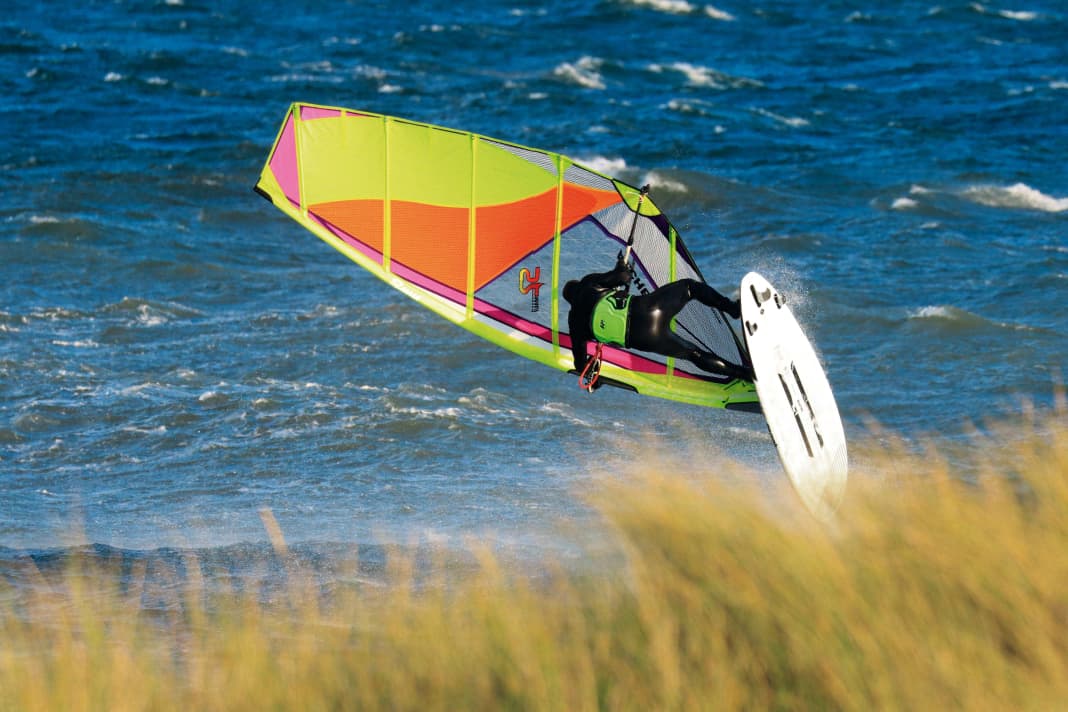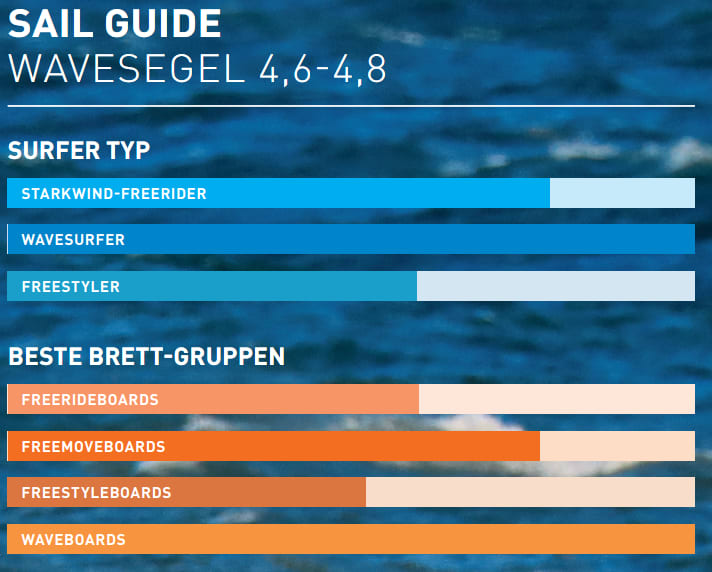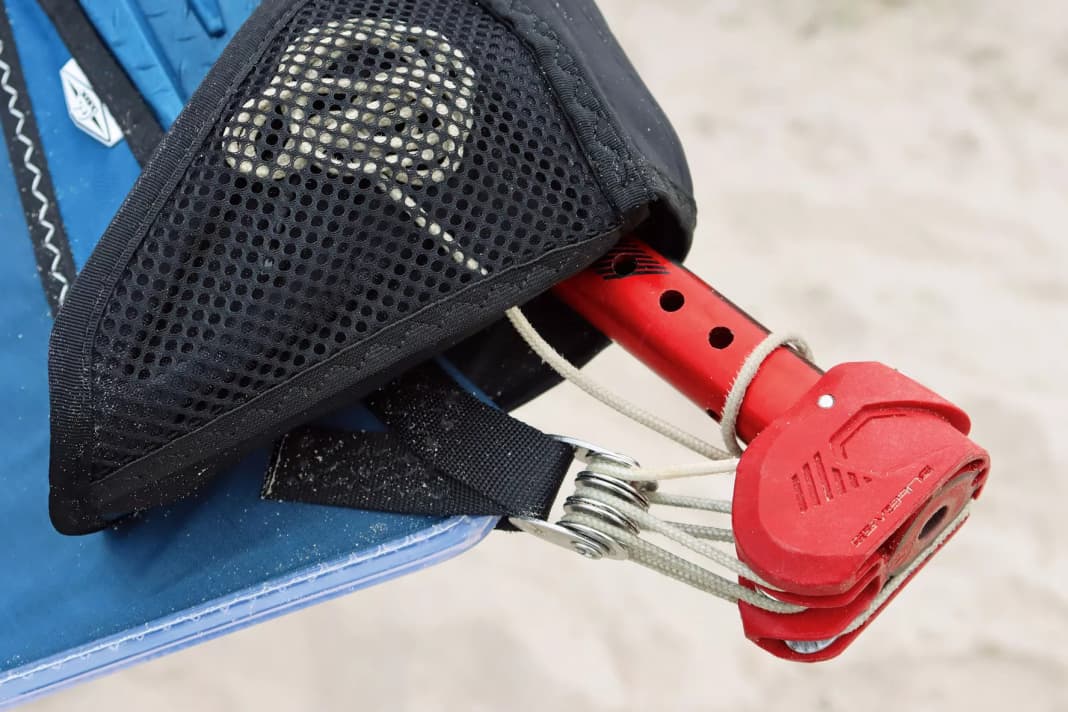Wave sails 2023: 12 wave sails from 4.6 to 4.8 square metres in the big surf test
Surf Testteam
· 07.04.2023






In this article:
You get stuck with the 4.7, somehow this size simply belongs in a well-stocked range of sails. The class of wave sails should rather be called all-round sails - because whether for use in the surf in the north, east or overseas or as a strong wind motor for flat water: this sail group can be used almost anywhere. Even as a flat water surfer or intermediate sailor, you should not be put off by the term "wave", because in sizes under 5.0 square metres the alternatives in other sailing classes are slowly becoming thin on the ground. However, because many manufacturers are aware that wave sails are also used to heat up flat water, many models are designed to be absolutely suitable for the masses.

These sails are included in the test:
Click to go to the individual ratings with even more detailed pictures
Features and details of the 2023 wave sails
There is just under 1.3kg difference in weight between the heaviest and lightest model in this group - a world of difference. The measured values are good additional information, but nothing more. Our years of testing experience show that the perceived weight on the water sometimes differs significantly from the measured values on the scales if, for example, the weight saving is achieved by using very thin (and therefore light) material. In extreme cases, this can mean that a sail distorts in gusts and the centre of pressure shifts - the light sail feeling is then quickly lost.
On the other hand, weight savings achieved through the use of high-quality materials can of course make a noticeable difference on the water. The idea here is that if tensile threads made of Aramide, Kevlar or carbon absorb the forces in the sail, the surrounding monofilm can be thinner and therefore lighter. The bottom line is that no sail in this test group makes an undersized impression. With the North Sails Wave, the fabulous weight of 2.27 kilos is largely achieved by the high-tech fibres and an almost seamless construction. However, weight is also consistently saved by dispensing with any chafe protection or metal trim rollers.
Click through these details of the wave sails






You can find even more details about each sail in the Individual ratings!
Mast lengths and trim
Most of the sails in the test group are rigged on a 370 mast. However, some models also offer the option of using a 400 mast. Especially if the 4.7 is the smallest sail size in your personal range, you may not need to use a 370 mast at all.
GA Sails Manic, Loftsails Wavescape, Naish Force 4 and NeilPryde Combat Pro all work on a 370 mast due to their luff dimensions. Goya Eclipse Pro, GunSails Seal, North Sails Wave, Patrik 5 Wave and Sailloft Curve were tested by us with a 370 mast, but in general both mast lengths are possible with these models and have also been tested by the manufacturer. With Goya and North Sails, however, you need a short adjustable extension to actually be able to use the 400 mast.
In general: If you use the longer 400 mast, every sail becomes a little stiffer - those who weigh over 90 kilos can sometimes benefit from the firmer sail feel. Conversely, we would advise users under 80 kilos to use the 370 mast in all cases, as this makes the sail a little softer and the profile develops a little better in light winds. RRD Vogue Pro, S2Maui Alchemy and Severne S1 are recommended by the manufacturers on 400 masts and have also been tested by us. Theoretically, these three models can also be ridden with a 370 mm mast - provided a long 36 mm extension is used. However, the 400 remains our clear recommendation, regardless of body weight.
When it comes to finding the right trim, brands such as Goya, GunSails, Loftsails, NeilPryde and RRD provide users with trim markings to help them find the right luff trim. In general, we keep seeing two basic design philosophies: sails such as the Goya Eclipse, Loftsails Wavescape, RRD Vogue HD, S2Maui Alchemy or Sailloft Curve are often rigged with a little more visible loose leech, but are attached to the boom with only a little tension and thus already work over a wide wind range when rigged.
Conversely, models such as the GA Sails Manic, Neil-Pryde Combat Pro or Severne S1 have what at first glance appears to be a flat profile with less basic tension. Here, the profile often needs to be adapted to the respective wind range with more trim sheet tension, but such sails usually also have a pronounced on-off characteristic, quasi power at the push of a button.
Which clew eyelet should I use?
GA Sails, Goya, Loftsails, Naish, Patrik and RRD equip their models with two clew eyelets. Which eyelet you should use usually depends less on your height than on the wind conditions. In general, the idea is to keep the leech more closed by using the upper eyelet in order to generate more planing power and propulsion when riding down the waves. Conversely, using the lower eyelet should allow the leech to twist more freely, so that the top opens better in gusts and ensures better controllability. In our experience, the further apart the two eyelets are positioned, the greater the perceived differences. With Goya and Loftsails, you can actually feel a clear difference between the two setups. If the eyelets are closer together - as with Patrik, Naish or GA Sails - the difference is manageable. A note on the Loftsails Wavescape: Due to the overall very high clew position, we would recommend using the lower eyelet - and attaching the sail to the trim sheet with almost no tension.
Surf type recommendation for the right wave sail
The twelve models in this test group are all made for big surf, but have certain strengths and weaknesses in the other areas of use, flat water freeride and freestyle, which can make the difference between top and flop in individual cases. Therefore, for an initial preselection, categorise yourself into one of the following three types, then you can be sure to avoid the worst bad buys.
Type: Strong wind heater
If you use your wave sail primarily for heating and jibing on freeride, freemove or freestyle waveboards and real surf days are the absolute exception - then you should choose a sail that takes you over the planing threshold without hesitation, is easy to ride, requires few trim adjustments and is easy to control even with intermediate riding skills. In this case, pay particular attention to the following criteria:
- Sliding properties:How well does a sail plane in medium trim (which also offers acceptable control) without pumping? If it is easy to find the right angle of attack to the wind and the profile loads up noticeably, this has a positive effect. Sails that require constant corrections are devalued - even if experienced surfers can make up for minor limitations with skill and pumping.
- Control in strong winds:How well does a sail in medium trim (which still offers acceptable planing performance) keep the centre of pressure stable? If there is an increasing pull on the sail hand in gusts and there are load changes on the hands that have to be compensated for with strength and technique, this will result in deductions.
- Drive:Sails with good drive offer constant propulsion, which is absolutely essential to avoid stalling in the bottom turn. The following models are perfect for strong wind heaters (in alphabetical order): Goya Eclipse Pro, GunSails Seal, Naish Force 4, NeilPryde Combat Pro, Patrik 5 Wave, RRD Vogue HD, Sailloft Curve, Severne S1.
Type: Omnivore
Do flat water and surf roughly balance each other out for you? Are you past the "wave beginner" stage, can you easily get through the surf and sometimes ride waves frontside to leeward? Are you also not generally averse to flat water sessions with classic moves such as carving 360, duck jibe or volcano? If you find yourself here, then pay particular attention to the following criteria - in addition to the "glide" and "control" scores already explained:
- Handling:Describes how handy a sail feels in gybes, duck jibes and other manoeuvres and how quickly it shifts and rotates. Sails with a pressure point further forward and flat battens often rotate more quickly and can be put down and raised again more quickly than sails with a pressure point further back and greater stability.
- The notes"Drive" and "neutrality" represent two poles, so to speak, which describe the general characteristics of a sail for wave riding. How you weight these notes for yourself is more a question of taste than of good or bad.
- Neutralitydescribes how well a sail releases pressure when unfurled and in the bottom turn. Sails with flat battens and soft characteristics can hide the profile when furling, ducking or riding waves at the push of a button and therefore offer a lot of off. You then ride waves over the board more like a surfer - rather than being pulled through the bend with powerful sail pull. The group of all-rounders is large, no sail in the group is unsuitable for this.
Strengths and weaknesses of the test sails at a glance
During testing, each tester keeps their board, only the sails are swapped. In this way, strengths and weaknesses become clear, which we always show in a rating scale.






All wave sails 2023 in the individual evaluation
Click here for the detailed test results of all wave sails:

